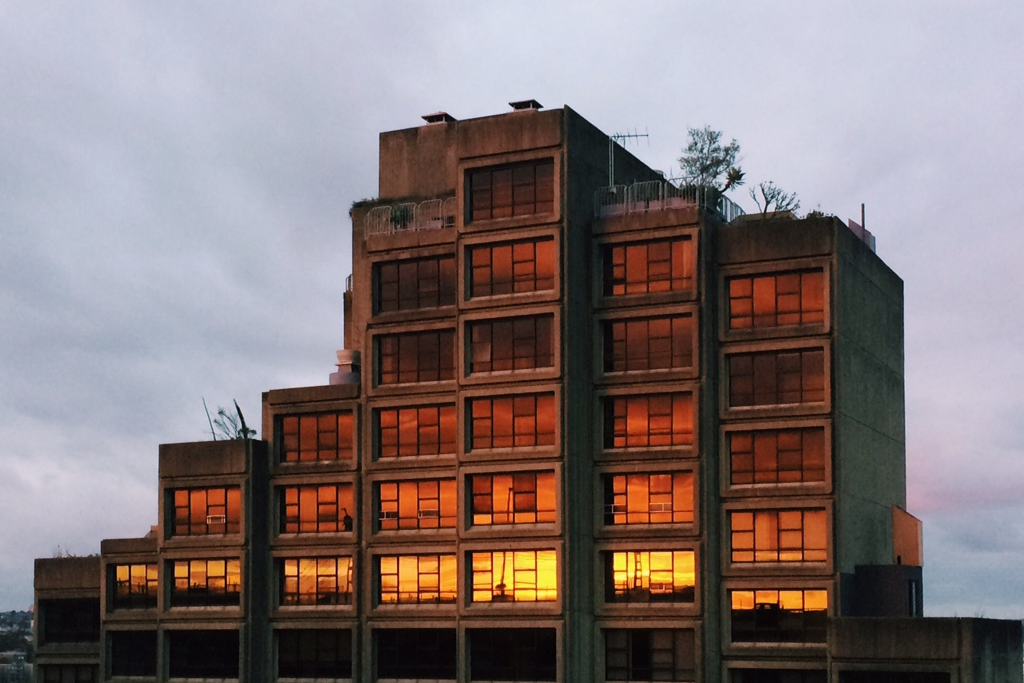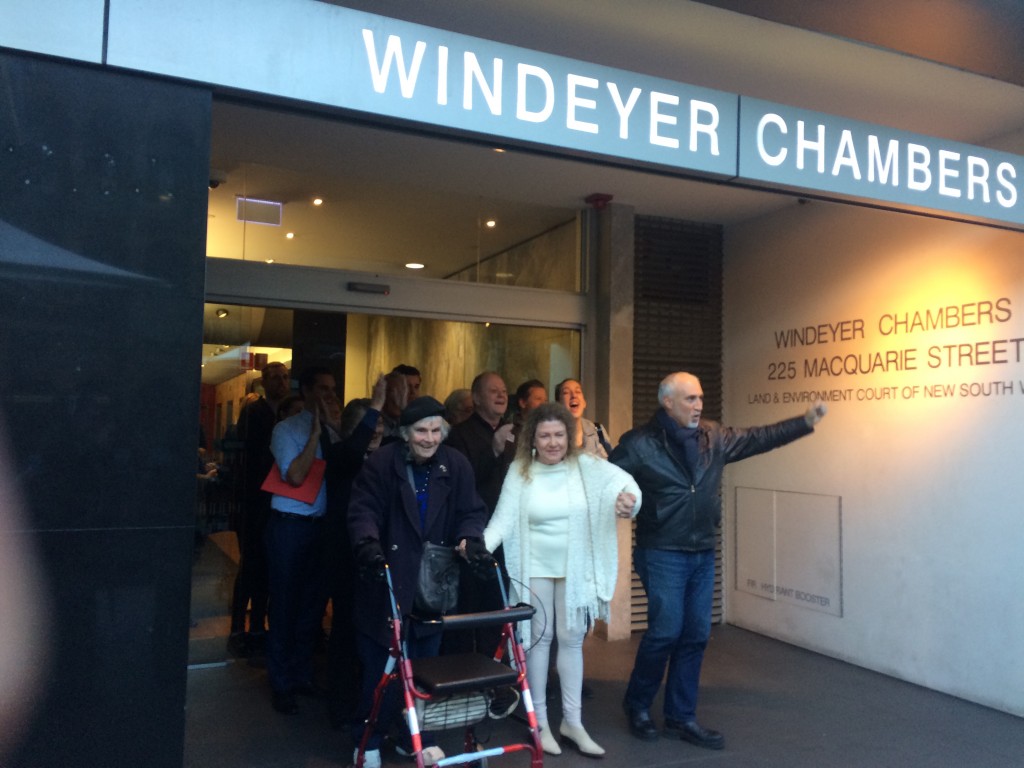You Can Fight City Hall: Public Housing Tenants Score Huge Win Over Government
GREAT NEWS.

For once things actually went the little guy’s way. In a huge win for fans of heritage, architecture and public housing, the Millers Point Community Association just won a crowdfunded legal challenge against the NSW Government over its refusal to heritage list Sydney’s iconic Sirius Building.
The decision, handed down by the NSW Land and Environment Court today, will force the NSW Minister for Heritage, Gabrielle Upton, to reconsider whether to heritage list the Sirius Building, which supporters argue is both an iconic example of Brutalist architectural style, and a historic site of union activism in Sydney. If you’re unfamiliar with it, the Sirius is that boxy concrete building next to the harbour bridge — it looks like a bunch of grey concrete lego with some plants on top, and until recently it had that “One Way! Jesus” sign in the window.
“It’s a bit numbing,” Save Our Sirius Chairperson Shaun Carter told Junkee after the decision. “One for the little guy”. The Sirius building’s two remaining residents, 90-year old Myra Demetriou and Cherie Johnson, were also relieved at the decision.

The judge also required the NSW government to pay the Save Our Sirius campaign’s legal costs.
The community’s legal action was launched last year in response to then-Minister for Heritage Mark Speakman’s refusal to heritage list the building despite a unanimous recommendation from the Heritage Council.
At the time, Speakman argued that the sale value of the site would be reduced by up to $70 million if it were to be heritage listed, and claimed that “whatever its heritage value, even at its highest, that value is greatly outweighed by what would be a huge loss of extra funds from the sale of the site; funds the government intends to use to build social housing for families in great need.”
While the Heritage Act allows for the Minister to consider whether a listing would cause “undue financial hardship” for a building’s owner, the community’s legal case argued that a potential loss of funds to the Government is not at all what was meant by “undue financial hardship”.
They also pointed out that in any case, the “undue financial hardship” clause was never intended to allow consideration of financial value to totally trump consideration of heritage value, as it appeared to have done in Speakman’s statement.
In today’s blistering judgement, Justice S. Molesworth agreed, determining that former Heritage Minister Mark Speakman’s decision not to heritage list the building was invalid because he did not adequately consider the heritage context in which the financial cost was incurred. The judge gave examples of the Sydney Opera House and Harbour Bridge to demonstrate that in some circumstances, the costs imposed by heritage listing would never be considered undue.
“It would be nonsense,” His Honour said, “to consider whether the impact is ‘undue’ in a vacuum.”
What Happens Next?
While the win is a big deal, it’s still only a little step forward. The next step will be for the Minister for Heritage to reconsider whether to list the Sirius Building on the NSW Heritage Register. She’s still free to say no, and is pretty likely to do so given the building’s huge potential sale value (and indeed, Minister for Social Housing Pru Goward has already tweeted that the government’s plans to sell Sirius are unchanged)
The NSW Government’s decision to sell the Sirius building remains unchanged. #nswpol
— Pru Goward (@PruGoward) July 25, 2017
In the meantime, the #SaveOurSirius campaign that has sprung up to defend the building will keep trying to convince people that a heritage listing is a good idea. For the past several years, they’ve been running tours of the building, holding rallies, commissioning art shows and posters, and basically doing everything they can to get the good word out about why it’s so important that this building stays.
“Sirius has been temporarily saved,” said Shaun Carter, “But what we say to the Minister and the Premier is, we ask you to hit pause on the demolition of Sirius and sit down with us.”
“We are desperately short of social housing, and Sirius has sat empty for months. Let’s now use it for what it’s intended for.”
Why Do People Think This Building’s So Important?

Millers Point and The Rocks, the suburbs of Sydney located just under the Harbour Bridge on the city side, are both historically working class areas that had a high population of dock workers back when the area was more industrial than touristy.
Back in the 1970s, when the government started making moves to transform the area, unions banded together to enact Green Bans, where unionised builders and labourers refused to work on demolition and development jobs opposed by the community.
At the time, Green Bans were implemented across Sydney for a range of reasons — to save the environment, to protect working class communities and public spaces, to preserve historic buildings like the terrace houses of The Rocks. It was one of the most successful union actions in Australian history, with coalitions of ordinary people standing up to government and developer power and actually winning.
Sirius was one of the biggest wins of that period. The building was constructed, in response to unions’ demands, in order to house the working class community who would otherwise have been displaced by development in the area. It’s a rare piece of thoughtful, purpose-built public housing, with communal spaces and gardens designed to make it feel like a home.
Of course, it hasn’t been without controversy, over both its aesthetics and purpose. Opponents say the building is one ugly motherfucker, and argue that retaining one piece of expensive public housing with harbour views is inefficient when its sale could fund more public housing in cheaper areas of Sydney. Supporters argue that the building is actually a rare and beautiful example of Brutalist architectural style, and that it is crucial that public housing residents aren’t pushed out of the CBD altogether.
In an ideal world, supporters of the building would love to see it retained in its historic role as public housing. Realistically, this is incredibly unlikely — the government has been evicting residents over the past year, and intends to sell the building, a plan that was never going to be affected by today’s court decision.
What a heritage listing could do, though, is ensure that at very least the building remains intact as a reminder of the architectural and union history of the area, preserving at least some of that story.
And as Shaun Carter said today, if the government is prepared to listen, it could do even more. “We’ve been having this discussion that neoliberal philosophies are failing us, it’s been taking from the poor and giving to the rich. This is a moment where we can stop and consider — what things are worth more than money?”
You can read more about the history of the Sirius building here, here, and here if you’re interested
–
Feature images by Sam Langford and alex.efimoff on Instagram.
–
Sam Langford is Junkee’s Staff Writer. She tweets at @_slangers.